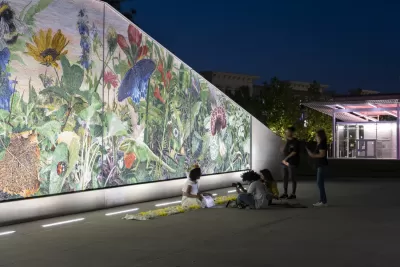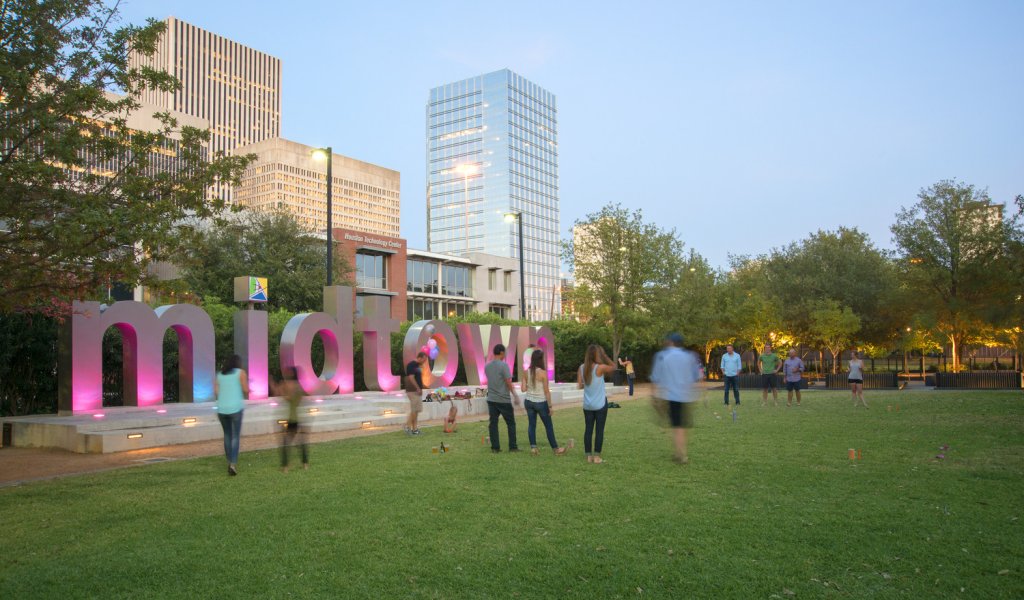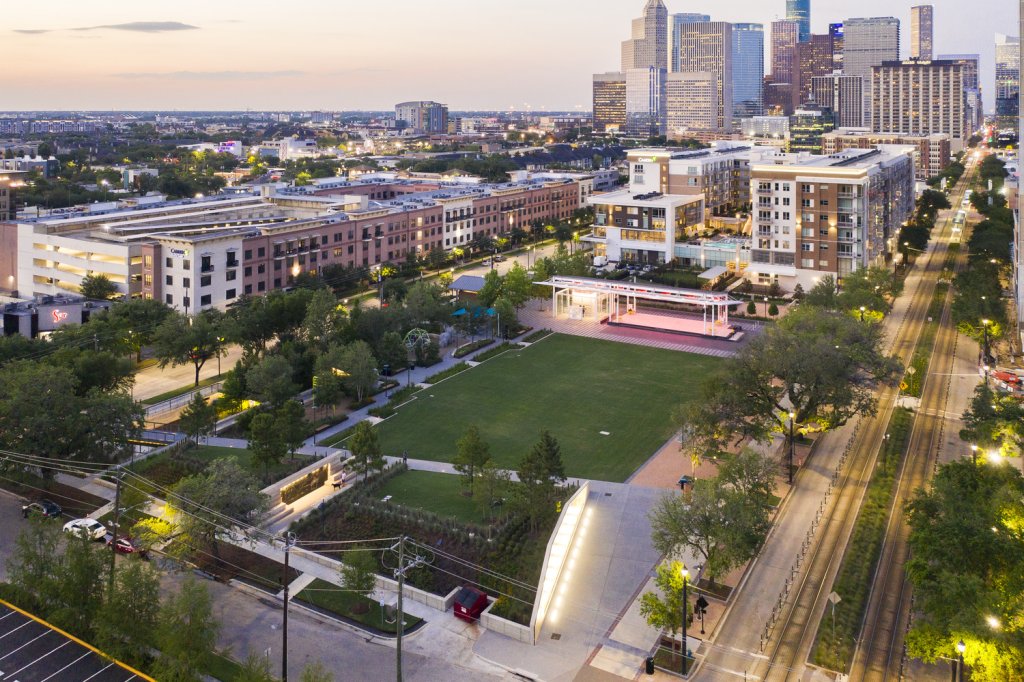Placemaking is often mistaken for a form of manufacturing. Every place already has a story to tell—placemaking just brings that story forward.

Successful placemaking awakens your senses and forms a connection to something authentically meaningful. That is why everyone—no matter how many times they’ve visited Midtown Park in Houston—is compelled to visit the art wall, bring their face within inches of the tiles, run their fingers over its edges, and gaze into the details. It’s more than just a selfie opportunity—it grounds visitors in Houston’s natural landscape while offering a sense of wonder and spectacle that keeps people coming back to find something new.
The Urban Land Institute (ULI) has recognized creative placemaking as “leveraging art and culture in tandem with great design...a proven accelerator for real estate development projects. It creates a distinctive sense of place—culturally rich, engaging, and economically thriving—and attracts people.”
So how do we achieve real, creative placemaking? We often think we must produce or orchestrate something to experience “placemaking.” This is where many designers, developers, and city planners get placemaking wrong.
We start with the belief that every place already has a history and a story to tell—that places already have soul. Our role as designers is to honor that story, bring it forward and integrate it into every level of design and detail, from the shaping of space to programming, lighting, materiality, and signage. The best measure of good placemaking is after having visited a place, you find yourself compelled to tell others about it. It becomes a place you’re excited to return time and again.

To build and expand upon the existing soul of a place, consider these guidelines:
Listen to the stories of the community. Honor the history, geography, economics, and the nature of the locality as the springboard for creating a sense of place. This context is best understood by truly listening to the people who use the space. Create multiple opportunities across accessible platforms to gather community input, and bring in local collaborators as much as possible. For Northwest Community Park and Frisco on the Green, in Frisco, Texas, we are collaborating closely with ecologists, local educators, and the city of Frisco to create a regional attraction to support education, local ecologies, and public health and wellness. This diversity of perspectives enables us to design a space with a sense of place that will meet the needs of the community around it.
Put yourself in someone else’s shoes. Any great place starts with understanding who you are designing for. For successful placemaking, we take it a step further by layering-in market analysis, diversity, equity, and inclusion (DEI) metrics, and demographic data to create personas that we use to simulate day-in-the-life studies. By mapping the persona movements, behaviors, and amenity preferences over the course of a day, we discover where activity converges and at what times of day. This allows us to focus and leverage public realm investments where it matters most.
Design for Tuesday. We all know that creating a vibrant public realm requires activating space through programming. Too often we think of activation as the annual holiday festival or the monthly concert series, but those events only happen a few times a year. The secret (and hard part) is how it feels on Tuesday morning. Midtown Park can host a concert for 1,500 people on Friday night, then a yoga class on Saturday morning. But it’s truly a magical experience to stroll through on Tuesday morning when nobody is around and you can hear the water rippling, the birds singing, and you forget you are in the city.
Utilize the right lighting. No matter what the existing conditions of a space look like, new lighting technologies and design techniques can always improve the quality of the end user experience, whether you’re a resident or visitor. We use the basic principle of phototropism, the human tendency to focus on and move toward light—to choreograph how people move through and experience the space, as well as dramatize its key features.
As with the other design disciplines, many of the opportunities that await us are derived by understanding the context. Is the surrounding streetscape bathed in a warm hue, which can evoke a more social, pedestrian friendly mood, or is it a cooler color hue that makes for a more bright, crisp aura? Are the streetlights steeped in historical importance, or are they contemporary fixtures? Are light levels low or high? Each of these cues can be used to ensure a place is engaged with its surroundings or can be used to purposely set it apart.
Incorporate environmental graphic elements. Not just for wayfinding, environmental graphics are critical to placemaking. They serve as art, backdrop, furniture, and landmark. They improve upon the functional experience of the place, such as signage showing how to move through the park, or the educational interpretive messaging woven throughout. As a design team, we are constantly balancing prescriptive and open-ended experiences: meeting needs, allowing for discoveries, and setting the scene for new expression.
Perhaps the most challenging part of placemaking is not knowing what will happen once the design is done. The people, visitors, and communities who will use this space will imprint themselves upon it in ways the design team could never have anticipated. Perhaps it becomes a stage for regular impromptu concerts or family Friday night picnics. Or it becomes the place that represents what the city means to you. In Midtown Park the mural is frequently the scene of photoshoots, local event postings and the ideal ending point to say goodbye to friends after a fun-filled night out. When we create legacy projects, we understand they live on and evolve with a life of their own beyond the page of our drawings. Not only are they enjoyed by the people they were created for many years to come, but they serve as a catalyst for growth and development in the community around them.

Brian Chambers, PLA, AICP is a champion of innovation, collaboration and design excellence. He is an urban designer, registered landscape architect and certified planner in Design Workshop’s Houston studio. Brian’s interest focuses on the creation of vibrant public spaces, destinations and mixed-use environment that offer bold community benefits, social activity, and economic return.
Fueled by curiosity, Renée Ludlam, Environmental Graphic Designer for Design Workshop, approaches each project as an exploration, seeking to discover what is distinct about each one and how best to share those stories. Throughout her 19 years of practice, Renée has led experiential, environmental and wayfinding designs that connect people to place. From massive to intimate projects, she is comfortable across all project scales and phases of design. Committed to co-creating with, not just for, stakeholders, Renée brings a strong sense of empathy to her collaborative process, facilitating open communication among clients, partners, teams, and communities.
Patrick Quigley, IALD is Lighting Design Principal at Design Workshop. His projects have garnered over 150 lighting awards including the AIA’s Allied Professions Honor Award for his body of work and its contribution to architecture. He has appeared in numerous articles and books on lighting over a 40 year career.

Maui's Vacation Rental Debate Turns Ugly
Verbal attacks, misinformation campaigns and fistfights plague a high-stakes debate to convert thousands of vacation rentals into long-term housing.

Planetizen Federal Action Tracker
A weekly monitor of how Trump’s orders and actions are impacting planners and planning in America.

Chicago’s Ghost Rails
Just beneath the surface of the modern city lie the remnants of its expansive early 20th-century streetcar system.

Bend, Oregon Zoning Reforms Prioritize Small-Scale Housing
The city altered its zoning code to allow multi-family housing and eliminated parking mandates citywide.

Amtrak Cutting Jobs, Funding to High-Speed Rail
The agency plans to cut 10 percent of its workforce and has confirmed it will not fund new high-speed rail projects.

LA Denies Basic Services to Unhoused Residents
The city has repeatedly failed to respond to requests for trash pickup at encampment sites, and eliminated a program that provided mobile showers and toilets.
Urban Design for Planners 1: Software Tools
This six-course series explores essential urban design concepts using open source software and equips planners with the tools they need to participate fully in the urban design process.
Planning for Universal Design
Learn the tools for implementing Universal Design in planning regulations.
planning NEXT
Appalachian Highlands Housing Partners
Mpact (founded as Rail~Volution)
City of Camden Redevelopment Agency
City of Astoria
City of Portland
City of Laramie





























